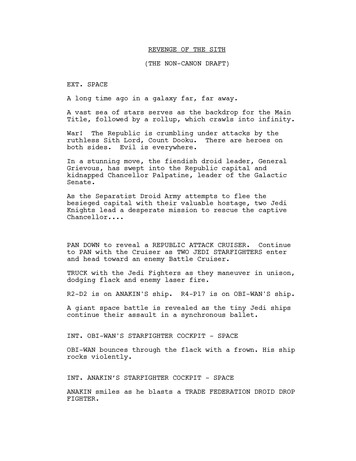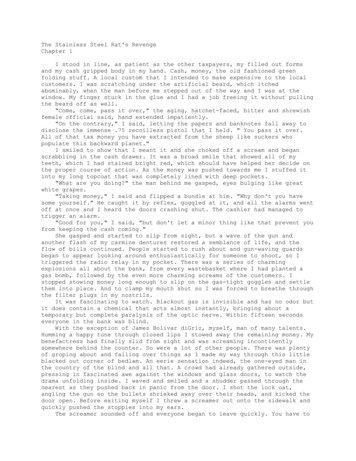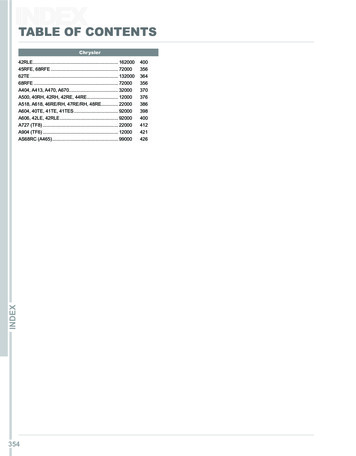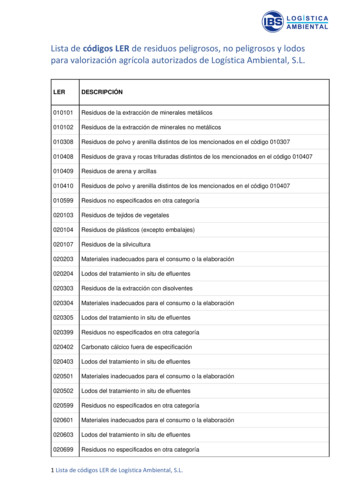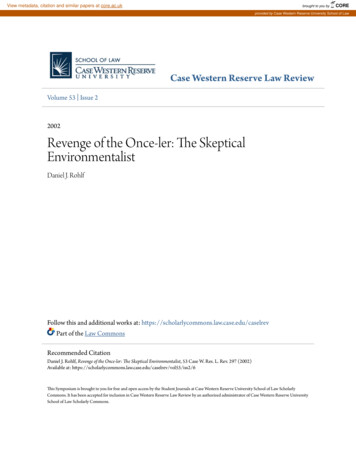
Transcription
View metadata, citation and similar papers at core.ac.ukbrought to you byCOREprovided by Case Western Reserve University School of LawCase Western Reserve Law ReviewVolume 53 Issue 22002Revenge of the Once-ler: The SkepticalEnvironmentalistDaniel J. RohlfFollow this and additional works at: https://scholarlycommons.law.case.edu/caselrevPart of the Law CommonsRecommended CitationDaniel J. Rohlf, Revenge of the Once-ler: The Skeptical Environmentalist, 53 Case W. Res. L. Rev. 297 (2002)Available at: 53/iss2/6This Symposium is brought to you for free and open access by the Student Journals at Case Western Reserve University School of Law ScholarlyCommons. It has been accepted for inclusion in Case Western Reserve Law Review by an authorized administrator of Case Western Reserve UniversitySchool of Law Scholarly Commons.
REVENGE OF THE ONCE-LER:THE SKEPTICAL ENVIRONMENTALISTDanielJ. Rohlf"UNLESS someone like you cares a whole awful lot, nothing isgoing to get better. It's not."-Dr. Seuss, excerptfrom "The Lorax' 'INTRODUCTIONSo reads the warning of Dr. Seuss's popular children's book,whose furry title character continually pops up at inconvenienttimes to point out a host of environmental misdeeds. The Loraxaims his criticisms at the Once-ler, an industrious creature whogets rich by cutting down nearly all of the trees in an idyllic valley,in the process polluting the air and water and chasing away thelocal animals. 2 In the book, the Once-ler ends up languishing inhis boarded-up factory amid self-inflicted environmental devastation, finally offering the book's ultimate lesson to a curious child.3In Bjorn Lomborg's world, however, the Once-ler fights back.With only a small nod to the Loraxes of our times, Lomborg acknowledges that modern development has had some environmentalimpacts. 4 But casting his lot solidly with the Once-ler's efforts,Lomborg argues that industrialization and its resulting materialwealth has both enhanced human welfare and enabled Westerncountries to afford the luxury of enhanced environmental protections. 5 He also contends that similar wealth accumulation eventually will enable developing countries to do the same, particularlyby buying pollution control and energy technologies from thet Associate Professor, Lewis and Clark Law School.I DR. SEUSS,THELORAX58 (1971).2Id. at 12-50.3 I. at 3-11.4 BJORN LOMBORG, THE SKEPTICAL ENVIRONMENTALIST: MEASURING THE REALSTATEOF THE WORLD (Cambridge University Press 2001) (1998).5 Id. at 176.297
CASE WESTERN RESERVE LAW REVIEW[Vol. 53:297West. 6 In the meantime, Lomborg-as-Once-ler loosens a statisticalbarrage of alleged portrayals of the "real" state of the environmentto support his assertions that forests are not falling at an alarmingrate, 7 that Brown Bar-ba-loots, Swamee-Swans, and their friends8are not becoming extinct in droves, that the Gluppity-Glup andSchoppity Schlopp in our air and water really are not that bad forus, 9 and that we'll all be better off in the end if we just trust andeven encourage the Once-lers among us to get on with creating1 more wealth, as well as inventing more Thneeds to solve our energy and environmental problems.l"Lomborg continues even beyond his view of the "real" stateof the world, in the process taking another page from Seuss lore.With a foray into social commentary, Lomborg heaps pointedcriticisms on the Lorax himself - who in Lomborg's mind is perInstitute.12sonified in real life by Lester Brown of the WorldWatchIn Dr. Seuss' story, the exasperated Once-ler, beset yet again bypreaching about the environmental impacts of acceleratingcommodity production, yells at the Lorax: "Now listen here Dad!All you do is yap-yap and say 'Bad! Bad! Bad! Bad! Well, I havemy rights, sir, and I'm telling you I intend to go on doing just what4I do!",13 Similarly, in The Skeptical Environmentalist,1 Lomborgtakes Brown and fellow environmentalists to task for continuallysubjecting a vulnerable public to "The Litany," which Lomborgsees as a vastly overblown but almost mindlessly repeated list ofenvironmental ills. 15 Such a false picture, according to Lomborg,encourages society to act out of fear, leading to over-regulation,overinvestment in measures to combat slight risks, and an unproductive sense of social guilt.' 6 Ultimately, Lomborg asserts, it isjust fine for modern society to go on doing just what we're doing6Id.7 Id. at 110-17.8 See id. at 249-57.9 See id. at 163-202.10 "A thneed's a Fine-Something-That-All-People-Need!" SEUSS, supra note 1, at 24.I LOMBORG, supra note 4, at 350-52.12 Id. at 27-31.13 SEUSS, supra note 1,at 49.14 With his book's title and his discussion of his Greenpeace background, Lomborg seemsto be saying that he comes to his rosy environmental conclusions only after being initially biased in the other direction. However, the title also might remind some of the stereotypical talkthat starts out "You're a really great person, but. " One has a pretty good idea what is comingnext.'5 LOMBORG, supra note 4, at 3-4, 327-28.16 Id. at 338-42.
2002]REVENGE OF THE ONCE-LERnow - in fact, doing exactly that is the recipe for a bright environmental future. 17The interesting question is whose book is a work of fiction that of Dr. Seuss or that of Professor Lomborg? Lomborg offerssupport for his thesis with a seductive mix of seemingly exhaustiveresearch (his book contains nearly 3,000 footnotes and sports a 70page bibliography), "common-sense" reasoning, and a homespunwriting style. However, closer analysis reveals a number of reasons to be skeptical of the neo-Once-ler. The scientific communityhas expressed little support for many of Lomborg's assertionsabout "real" global environmental trends, 18 and commonly employed indicia of scientific veracity provide little reason to givecredence to a statistics professor's substantive (as opposed tomethodological) conclusions on everything from extinction rates toglobal economics. 19 Moreover, even if one assumes for the sake ofargument that many of Lomborg's factual contentions are correct,they do not support many of his broad prognostications of a brightglobal future. 20 This is particularly true of Lomborg's almost casual optimism that development and technology will soon overcomethe twin scourges of poverty and environmental degradation thatplague many of the world's poorer countries. 2 1 Lomborg also ignores or dismisses the role of environmental regulations in improving the state of the global environment, a perplexing stance giventhat these regulatory regimes are directly responsible for many ofthe environmental improvements that he trumpets.22 Lastly, eventhough analyzing broader trends can sometimes provide useful insights, Lomborg fails to recognize that many environmental problems are local - as solutions must be as well.On the other hand, however, The Skeptical Environmentalistdoes hold a few lessons that modern-day Loraxes should consider.Lomborg's book is in large part a reaction to the scare tactics,gloomy messages, and alarming - and occasionally somewhatspeculative - statistics that the environmental movement some-17 Id. at 350-52.18 See John Rennie, Misleading Math About the Earth, SCIENTIFICat 61.AMERICAN, Jan. 2002,9 Id. (Lomborg's view "is often marred by an incompetent use of the data or a misunder-standing of the underlying science").20 Id. ("Even where [Lomborg's] statistical analyses are correct, his interpretations arefrequently off the mark.").21 See John Bongarts, Population:Ignoring its Impact, SCIENTIFIC AMERICAN, Jan. 2002,at 67-69 ("Lomborg's view that 'the number of people is not the problem' is wrong.").22 See Michael Grubb, Relying on Manna from Heaven? 294 SCIENCE 1285, 1285 (2001)(book review) (citing examples where policy driven legislation has improved the environment).
CASE WESTERN RESERVE LAW REVIEW[Vol. 53:297Faced with suchtimes employs to make its case to the public.consistently "downer" messages, Lomborg warns, at least a portionof the populace may lapse into apathy or "hide" from problemsthey perceive as overwhelming (of course, bad tidings spread byenvironmentalists also tend to make the public and media are eagerto grasp rose colored glasses peddled by people such as Lomborg).And though Lomborg takes the concept too far, it may make senseto include some consideration of relative risk when making decisions about allocating resources to reduce threats to humans andthe environment. Finally, Lomborg's tome should also serve as areminder of the power of economics for those concerned with ourenvironmental fate. The Danish professor is probably not far offthe mark in painting at least partial solutions to a number of environmental problems in terms of economics - even if his book isfuzzy on how to change current economic systems to realize thosefixes.I.BYE BYE BJORNLomborg devotes much of his effort to showing that LesterBrown and his fellow Loraxes are wrong in painting a gloomy picture of current environmental trends, and that society thus shouldlargely ignore their warnings.24 To do this, of course, Lomborgmust first describe what he thinks constitutes "The Litany" thatenvironmentalists preach.25 Next, Lomborg attempts to dazzlereaders with a vast array of "facts," backed up by figures, graphs,26Finally, he employsand a profusion of circuitous footnotes.these "facts" to reach an array of broad findings diametrically opposed to his characterization of those that form "The Litany,"Lomborg concludes that most everything from the environment tointernational economics to human health is just fine and getting27However, while Lomborg's graphics arebetter all the time.impressive looking and his assertions sound plausible, in the end23 See LOMBORG, supra note 4, at 3-5 (citing examples where television and newspaperssend the message that the environment is in bad shape).24 See id. at 327-30 (criticizing Brown's views as "myths").25 See id. at 3-4. Lomborg's Litany is that: (1) the environment is in poor shape; (2) theearth's resources are running out; (3) population growth is leaving less and less to eat; and (4)the air and water are becoming ever more polluted. See id. at 4.26 Lomborg's footnotes are frustratingly difficult to follow, as well as ultimately oftenincomplete. The notes themselves refer readers to the bibliography, requiring the reader to lookin two places to pin down the sources of his factual assertions. Often, however, neither citationprovides the specific page or graphic that supposedly supports Lomborg's point. See, e.g., id. at377 n.833.27 See id. at 4 ("Mankind's lot has actually improved in terms of practically every measurable indicator.").
20021REVENGE OF THE ONCE-LERpressive looking and his assertions sound plausible, in the endthere are ample reasons to question his conclusions.Before attacking "The Litany," Lomborg had to first describeits tenets. This he does in many cases by setting up an extremiststraw man that practically begs to be knocked down. For example,he quotes two obscure Danish publications calling acid rain an"ecological Hiroshima,",28 and "one of the mostserious threats tolife here on Earth., 29 Even a decade ago, however, few environmental organizations portrayed the phenomenon in such alarmingterms. But for Lomborg, it would have been much less dramatic totake issue with a more accurate characterization of the problem asa chronic stressor of lakes, forests, and soils, as well as a contributor to regional haze and chronic human health effects.In looking for additional sources of environmental gloom anddoom to pillory, Lomborg often quotes media sources. 30 His discussion about the public's fear of cancer, for example, cites anumber of magazine articles warning of a modern cancer "epidemic.",3 1 In doing so, the Danish Once-ler in essence criticizesthe Lorax for the way the Truffula Valley Times characterizes thefurry environmentalist's message.3 2 Lomborg thus misses themark in his efforts to critique "The Litany" itself, since manytimes he refers only to what some in the media report as environmental problems. 33 Lomborg makes a valid a point in showing thatsome in the media may overemphasize environmental problemsand risks, just as, for example, other media critics have pointed outthat sensational stories on violent crimes give the public a falseimpression of the world as a place with murderers and childsnatchers behind every bush. However, Lomborg needs to beclearer that there is a meaningful difference between what the scientific and environmental communities portray as the state of theenvironment versus how the media characterizes environmentalproblems and fears.All of the above, though, is just prelude to the key question:does The Skeptical Environmentalistlive up to its billing by accurately setting forth the "real" state of the world? If the answer isaffirmative, many more people should read his book, becauseId. at 178.Id.30 See, e.g., id. at 215-16, 39-42.32 Id. at 216.12 ld. at 215 (examining response to Rachel Carson's SILENT SPRING).33 See id. at 216-17.2829
CASE WESTERN RESERVE LA W REVIEW[Vol. 53:297Lomborg reaches some amazing findings. 34 Some examples: acidrain may make forests grow faster, not harm them; 35 freshwaterpollutants in the United States and the United Kingdom have de36clined 80-90% over the past couple of decades; a cornerstonetheory of conservation biology may not work in many places, andoverstated; 37reports of losses of biological diversity are vastlyglobal climate change will not decrease food production, will notincrease damage from storms and hurricanes, and will not increasemalaria; 38 and more than 85% of the developing world - and 90%39of the entire world - has never been as "rich" as it is now. Lomborg uses these and many similar contentions to support his ultimate conclusion that the world's environment and economy arejust fine, and will only improve even without measures advocatedby environmentalists.This message, of course, has been warmly received by a hostof people and institutions with economic or political stakes inmaintaining the status quo. A number of reviewers and punditswithout such interests have also embraced the book, apparentlyimpressed enough with all of the book's graphs and footnotes todispense with much critical analysis of whether Lomborg's provocative assertions are accurate.So what is a more skeptical reader to do? Should Lomborg'sresearch and conclusions prompt a far-reaching factual reassessment of what appears to be considerable uncertainty over the"real" state of the global environment and economy, as well asideological soul-searching over what this means for modern society? The answer is quite simple - not just "no," but "heck no."34 Lomborg also goes through some equally amazing statistical exercises to reach hisconclusions. My own favorite is his analysis dismissing reports of decreases in sperm countover recent decades in human males, which some have attributed to feminization in males as aresult of estrogen-mimicking chemicals in air, water, and food. Id. at 238-41. In an effort toprove that such concerns are unfounded, Lomborg asserts that men in New York have highersperm counts than nearly anywhere else in the world (though no one knows exactly why!), andthus the use of New Yorkers in several of the sperm count studies skews their results. Id. at239, 244. Moreover, Lomborg also asserts that men have a lot more sex today than in pastdecades, which tends to naturally lower the number of sperm per ejaculation. Id. at 240. Sovoila! - studies that show what looks like statistical indications of lower sperm counts over timereally just reflect the fact that men in New York are really virile and that we're all having a lotmore sex these days. See id. at 239-40. 1can't wait to see the episode of HBO's "Sex and theCity" when Carrie reads The Skeptical Environmentalist!35 Id. at 179-80.36 Id. at 204-05, 205 fig. 112.37 Id. at 253-54, 257 (discussing actual losses of biological diversity and consequences ofoverstating extinctions).38 Id. at 317.39 Id. at 77.
REVENGE OF THE ONCE-LER2002]In deciding whether to act upon or even consider extrinsic information, both individuals and institutions naturally apply athreshold test of whether the source of the information is credibleand reliable;40 for this reason, few people take much notice of theperson on a street corner with a sign warning that judgment day isnigh. An important reason underlies this behavior; with limitedtime and resources, one must develop a mechanism for discardinginformation when the cost of assessing its validity is likely to exceed the information's worth, or when merely considering the information is likely to lead to unwarranted fear or prejudice.The U.S. Supreme Court interpreted the Federal Rules of Evidence to include this common sense notion in Daubert v. Merrell41Dow Pharmaceuticals.In that case, the Court held that federaljudges must act as "gatekeepers" of good science to insure therelevance and reliability of scientific evidence used in resolvingcivil disputes. 42 Rejecting the former test that judges should consider admissibility of scientific evidence solely based on whether itis "generally accepted" in a particular field, the Court encouragedjudges to conduct a "flexible" inquiry that, in addition to "generalacceptance," considers as indicia of "good" science factors such aswhether a theory or technique has been tested, whether it has beensubjected to peer review and published, and a theory's known orpotential rates of error. 43 Courts apply the Daubert test as scientific gatekeepers in order to prevent interminable trials, as well asto avoid exposing juries to information that may affect their judgments, yet that is not reliable or relevant. 44 Before attempting theconsiderable task of stacking Lomborg's facts and figures up withthose from other sources and attempting to decide whom to believe, it makes sense to apply this sort of a "gatekeeper" inquiry to40 Cf id. at 348-52 (discussing how environmental policies should be decided in the future).41 509 U.S. 579 (1993).42Id. at 589 n.7, 597.43 Id. at 593-94." See Tome v. U.S., 513 U.S. 150, 163 (1995) (Breyer, J., dissenting) ("The judge mayreject the evidence .only if the probative value of the evidence is substantially outweighed byits tendency to prejudice a party or delay a trial."); In re TMI Litigation, 193 F.3d 613, 664 (3dCir. 1999) ("Rule 403 .permits the exclusion of relevant evidence if its probative value issubstantially outweighed by the danger of unfair prejudice .) (citing Daubert, 509 U.S. at595); In re Paoli R.R. Yard PCB Litigation, 35 F.3d 717, 747 (3d Cir. 1994) ("The Court notedthat Rule 403's balancing test of the probative against the prejudicial value of evidence has aspecial role in cases involving expert witnesses.") (citing Daubert, 509 U.S. 579)); State v.Porter, 698 A.2d 739, 794 (Conn. 1997) (Berdon, J., dissenting) ("[W]e not only adopted theIconsiderations' that the court in Daubert delineated . but we also made clear that the admissibility of scientific evidence was subject to the limitations of rule 403 by stating that 'scientificevidence, like all evidence, is properly excluded if its prejudicial impact substantiallyoutweighsits probative value .'").
CASE WESTERN RESERVE LAW REVIEW[Vol. 53:297The Skeptical Environmentalist to decide whether or not it is evenworth the trouble.In such a threshold analysis, Lomborg and his book fail spectacularly. At the outset, one must question whether Lomborg, astatistics professor, is qualified to draw any substantive scientific,economic, and medical conclusions, let alone the sweeping conclusions he reaches on issues that have been debated in various expertcircles for decades. His background provides him with the credentials to critique statistical methods that others have employed inassessing environmental and economic issues, or to suggest whathe views as more accurate statistical methodology to apply to suchquestions. Lomborg, however, shops around for his own data, applies statistical analyses to the data, draws conclusions, and thenexplains what these conclusions mean for society. Competence inonly one of these four areas does not make Lomborg enough of anexpert to merit attention as one who knows much of anythingabout the "real" state of the world.Additionally, with the obvious exception of a book marketedto what is essentially a popular audience, Lomborg's facts andconclusions have not been subject to peer review and publication.In order for a scientist to have a paper published in a reputablejournal, it must first pass muster with an editor who herself is anexpert in the relevant field, as well as a panel of anonymous reviewers.4 5 Only if the reviewers recommend publication (usuallyafter considerable changes to the paper's analysis and conclusions,or even to its methodology) does the paper go to press. Though it45 See Daubert v. Merrell Dow Pharm., Inc., 951 F.2d 1128, 1131 (Cal. Ct. App. 1991)(vacated by 509 U.S. 579 (1993)) ("[T]he best test of certainty we have is good science - thescience of publication, replication and verification, the science of consensus and peer review."(quoting P. HUBER, GALILEO'S REVENGE: JUNK SCIENCE IN THE COURTROOM 228 (1991));Valentine v. Pioneer Chlor Alkali Co., Inc., 921 F. Supp. 666, 670 (D. Nev. 1996) ("One indication that the proposed evidence is the result of good science is proof that the research and analysis supporting the expert witness's conclusions have been subjected to normal scientific scrutinythrough the process of "peer review" and through publication in a generally-recognized scientific journal that conditions publication on a bona fide process of peer review.") (citing Daubertv. Merrell Dow Pharm., Inc., 43 F.3d 1311, 1318 n.6 (9th Cir. 1995)); see also William L.Anderson et al., Daubert's Backwash: Litigation-GeneratedScience, 34 U. MICH. J.L. REFORM.619, 621 (2001) (describing the methods and effects of peer review and publication); Effie J.Chan, The "Brave New World" of Daubert: True Peer Review, 70 N.Y.U. L. REV. 100, 117(1995) (describing the process of editorial peer review in scientific journals and noting the"general correlation between a journal's prestige and the quality of its editorial peer review.");Lars Noah, Sanctifying Scientific Peer Review: Publication as a Proxy for Regulatory Decisionmaking, 59 U. Prrr. L. REV. 677, 693 (1998) (editorial peer review "represents the scientificcommunity's effort to police itself and to assure a certain minimum level of quality so that scientists and others can rely on the results of reported scientific research."). Noah's article describes the process and notes, "[plublication in peer-reviewed journals is one of the most important mechanisms for screening, disseminating, and preserving new research results. In a sense,publication represents the currency of scientific activity." Id. at 695.
2002]REVENGE OF THE ONCE-LERcan have flaws, scientists almost universally regard this process asa key indicator of a paper's reliability. 46 Lomborg has never published in a peer-reviewed journal any of the findings he reports inThe Skeptical Environmentalist.It is unlikely that he could do so. Scientists who have beenrecognized as experts in their respective fields - and who have authored many papers in peer-reviewed journals - have almost universally excoriated both Lomborg's factual assertions and thebroader conclusions he draws from them. 47 Also providing a good46 Lomborg, however, seems better acquainted with the popular media than with scientificpublications. For example, he devotes a box on page 36 to arguing that scientists have a difficult time publishing their results unless their conclusions are interesting or provocative, even ifthose conclusions may have resulted from some purely coincidental relationship. While thismay be a valid criticism of some popular media - for instance, one might speculate whether ahigh profile publisher would have found a book on the global environment very attractive had itmerely once again pointed out the problems society faces rather than arguing that these problems have been trumped up by a semi-conspiracy among environmentalists, scientists, and governments - it demonstrates either ignorance or disregard of scientific peer review, the purpose ofwhich is to avoid publishing any results based on mere coincidence.47 See Mikael Skou Andersen, The Lomborg debate: Some repliesfrom Danish scientiststo a Contrarian(Dec. 31, 2000), at http://www.au.dk/-cesamat/debate.html ("In each their [sic]professional field, the researchers argue against the interpretations that Bjorn Lomborg havegiven, and provide counter-arguments that are for the reader to consider."); Sherry Bosse, TheLomborg and Short of It: Links related to The Skeptical Environmentalist, GRIST MAGAZINE,Dec. 12, 2001, at 01.asp (links to sites that"praise the man, haze the man, and walk the middle ground."); Douglas A. Kysar, Some RealismAbout EnvironmentalSkepticism, at 63, at 60 code020907500.pdf?abstractid 323460:[Lomborg] fails to acknowledge that his preferred method of policy review is built upon its own tenets of faith. They are less transparent thanthe frequently charged rhetorical appeals of environmentalists, but theyexist and often are backed by the same fervor that Lomborg appears toderide as non-rational . [The reliability of his decisions] depends notupon scientific evidence but upon the quality of their moral justification.Lomborg, regrettably, appears not to have comprehended this point, anomission that leaves the careful reader decidedly skeptical about TheSkeptical Environmentalist.(last visited Oct. 16, 2002); Jim Norton, Correcting Myths from Bjorn Lomborg, athttp://www.info-pollution.com/lomborg.htm (providing links to sites criticizing Lomborg'sbook) (last viewed Oct. 16, 2002); John Rennie, Misleading Math About the Earth: ScienceDefends Itself Against The Skeptical Environmentalist, SCI. AM. 61 (Jan. 2002):The problem with Lomborg's conclusion is that the scientists themselves disavow it. Many spoke to us at Scientific American about theirfrustration at what they described as Lomborg's misrepresentation oftheir fields. His seemingly dispassionate outsider's view, they told us, isoften marred by an incomplete use of the data or a misunderstanding ofthe underlying science. Even where his statistical analyses are valid, hisinterpretations are frequently off the mark - literally not seeing the stateof the forests for the number of the trees, for example.World Resources Institute, Debunking Pseudo-Scholarship: Things a Journalist Should KnowAbout The Skeptical Environmentalist (last updated July 23, 2002), at http://www.wri.org/press/mklomborg.html (providing links to critical articles written by environmental groups, environmental scholars, and scientists: "Lomborg paints a caricature of the environmental agendabased on sometimes mistaken views widely held 30 years ago, but to which no serious environmental institution today subscribes. In making the case for a more rational and scientific debate
CASE WESTERN RESERVE LAW REVIEW[Vol. 53:297indication of the general acceptance of his book in scientific circles, a long list of luminaries of the technical world have not beengentle on the modern Once-ler. Dr. E.O. Wilson, for example,who in addition to world-wide scientific acclaim has won two Pulitzer Prizes for his own books, called Lomborg part of "the parasite load on scholars who earn success through the slow process ofpeer review and approval. 48 Dr. Peter Gleick at the Pacific Institute for Studies in Development, Environment, and Security declared that "Lomborg's understanding of basic environmental science concepts and the nature of risk assessment are highlyflawed., 49 Finally, lamenting that popular publication of Lomborg's book has essentially forced the scientific community to dealwith findings it would have never accepted through standard scientific channels, climate expert and MacArthur Fellow Dr. StephenSchneider commented as follows: "What a monumental waste ofbusy people's time countering the scores upon scores of [Lomborg's] straw men, misquotes, unbalancedstatements, and selec50tive inattention to the full literature."Dr. Schneider's statement emphasizes one of the importantreasons behind dismissing Lomborg's thesis without the necessityof going through each of its elements point by point, namely thatsuch a process is not worth the time because the source is notcredible in the first place.51 Still, some might cry foul at the ideaof simply dismissing Lomborg on the grounds that he and his bookfail some sort of threshold test; surely, these people will contend,the "marketplace of ideas" is the best way to sort out whether or52not The Skeptical Environmentalist contains worthy information.on environmental issues, Lomborg commits the same sins for which he attacks environmentalists. He exaggerates, makes sweeping generalizations, presents false choices, is highly selectivein his use of data and quotations and, frequently, is simply wrong."); see also infra notes 48-50and accompanying text.41 E.O. Wilson, Vanishing Point: On Bjorn Lomborg and Extinction, GRIST MAGAZINE,Dec. 12, 2001, at p.49 Peter H. Gleick, Where's Waldo: A Review of the Skeptical Environmentalist, Union ofConcernedScientists, at 7, at D 3936, 2002).(Nov.50 Stephen H. Schneider, Hostile Climate: On Bjorn Lomborg and Climate Change, GRISTMAGAZINE, Dec. 12 2001, at .asp.51 Indeed, one must question whether it is worth devoting a law review symposium toLomborg's book, when law professors could be otherwi
Revenge of the Once-ler: The Skeptical Environmentalist Daniel J. Rohlf Follow this and additional works at:https://scholarlycommons.law.case.edu/caselrev Part of theLaw Commons This Symposium is brought to you for free and open access by the Student Journals at Case Western Reserve University School of Law Scholarly Commons.



